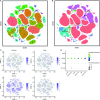Exploring the prognostic value of T follicular helper cell levels in chronic lymphocytic leukemia
- PMID: 39341925
- PMCID: PMC11438893
- DOI: 10.1038/s41598-024-73325-8
Exploring the prognostic value of T follicular helper cell levels in chronic lymphocytic leukemia
Abstract
Chronic lymphocytic leukemia (CLL) presents with heterogeneous clinical outcomes, suggesting varied underlying pathogenic mechanisms. This study aims to elucidate the impact of T follicular helper (Tfh) cells on CLL progression and prognosis. Gene expression profile data for CLL were collected from GSE22762 and GSE39671 datasets. Patients were divided into high and low groups using Tfh levels using the optimal cutoff value based on overall survival (OS) and time-to-first treatment (TTFT). Differential expression analysis was performed between these groups, followed by co-expression network analysis and single-sample Gene Set Enrichment Analysis (ssGSEA). Marker genes of Tfh cells were used to construct prognostic models. Additionally, 40 CLL patients were recruited and categorized based on median Tfh levels. Marker gene expression was assessed using RT-qPCR and Western Blot, and immune cell levels were determined through flow cytometry. The high group showed better prognosis compared to the low group. Among the 1121 differentially expressed genes identified, five co-expression networks were constructed, with the turquoise module showing the highest correlation with Tfh cells. Genes within this module significantly participate in cytokine-cytokine receptor interaction, PI3K-Akt signaling pathway, and natural killer cell mediated cytotoxicity. Tfh cells were significantly negatively correlated with activated B cells and positively correlated with Tregs. The Random Survival Forest (RSF) model identified 10 marker genes, and further analysis using Lasso regression and nomogram selected CLEC4A, RAE1, CD84, and PRDX1 as prognostic markers. In the high group, levels of CLEC4A and RAE1 were higher than in the low group, whereas CD84 and PRDX1 were lower. Flow cytometry revealed that the level of activated B cells in the high Tfh group was significantly lower than in the low Tfh group, while the level of Tregs is significantly higher in the high Tfh group. This study seeks to contribute to a more detailed understanding of the pathogenesis of CLL, delving into the prognostic significance of Tfh.
Keywords: Chronic lymphocytic leukemia; Prognostic genes; Tfh; Time-to-first treatment.
© 2024. The Author(s).
Conflict of interest statement
The authors declare no competing interests.
Figures










Similar articles
-
Elevated levels of follicular T helper cells and their association with therapeutic effects in patients with chronic lymphocytic leukaemia.Immunol Lett. 2018 May;197:15-28. doi: 10.1016/j.imlet.2018.03.002. Epub 2018 Mar 8. Immunol Lett. 2018. Retraction in: Immunol Lett. 2019 Jun;210:63. doi: 10.1016/j.imlet.2019.05.005. PMID: 29526569 Retracted.
-
Identifying a novel ferroptosis-related prognostic score for predicting prognosis in chronic lymphocytic leukemia.Front Immunol. 2022 Oct 6;13:962000. doi: 10.3389/fimmu.2022.962000. eCollection 2022. Front Immunol. 2022. PMID: 36275721 Free PMC article.
-
Elevated levels of circulatory follicular T helper cells in chronic lymphocytic leukemia contribute to B cell expansion.J Leukoc Biol. 2023 Mar 1;113(3):305-314. doi: 10.1093/jleuko/qiad006. J Leukoc Biol. 2023. PMID: 36807447
-
Prognostic models for newly-diagnosed chronic lymphocytic leukaemia in adults: a systematic review and meta-analysis.Cochrane Database Syst Rev. 2020 Jul 31;7(7):CD012022. doi: 10.1002/14651858.CD012022.pub2. Cochrane Database Syst Rev. 2020. PMID: 32735048 Free PMC article.
-
The immunoglobulin genes and chronic lymphocytic leukemia (CLL).Ups J Med Sci. 2005;110(2):97-113. doi: 10.3109/2000-1967-075. Ups J Med Sci. 2005. PMID: 16075892 Review.
Cited by
-
A potential XGBoost Diagnostic Score for Staphylococcus aureus bloodstream infection.Front Immunol. 2025 Apr 22;16:1574003. doi: 10.3389/fimmu.2025.1574003. eCollection 2025. Front Immunol. 2025. PMID: 40330459 Free PMC article.
References
MeSH terms
Substances
Grants and funding
LinkOut - more resources
Full Text Sources
Miscellaneous

